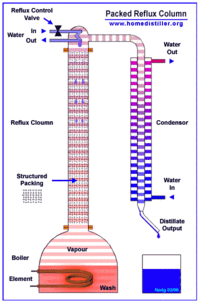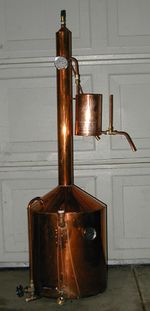Still: Difference between revisions
Uncle Jesse (talk | contribs) No edit summary |
No edit summary |
||
| (5 intermediate revisions by 2 users not shown) | |||
| Line 1: | Line 1: | ||
[[File:stillanimation2.gif|thumb|200px|right|Animated Reflux Still]] | |||
[[File:still.jpg|thumb|150px|right|Copper still with fractionating column]] | |||
Stills come in many designs. The most common stills are traditionaly made of copper, though in recent years [[stainless steel]] has made inroads in the industry. Almost all stills employ some sort of copper because it removes sulphates on contact. | Stills come in many designs. The most common stills are traditionaly made of copper, though in recent years [[stainless steel]] has made inroads in the industry. Almost all stills employ some sort of copper because it removes sulphates on contact. | ||
A very detailed page on column still design is [[ | A very detailed page on column still design is [[How To Build A Bokakob Reflux Still|How to build a Bokakob Still]]. | ||
There are two common designs of stills. The first and most common is the [[pot still]] which is used to produce [[whisky]], [[brandy]] and other spirits which rely on flavor from the [[mash]]. Pot stills consist of a [[boiler]], a [[condenser]], and a lyne arm through which vapor travels from the [[boiler]] to the condenser. The lyne arm has a bend in it known as the lyne angle. Some pot stills have a [[thumper]] which serves to further purify the distillate. A [[Heat | There are two common designs of stills. The first and most common is the [[pot still]] which is used to produce [[whisky]], [[brandy]] and other spirits which rely on flavor from the [[mash]]. Pot stills consist of a [[boiler]], a [[condenser]], and a lyne arm through which vapor travels from the [[boiler]] to the condenser. The lyne arm has a bend in it known as the lyne angle. Some pot stills have a [[thumper]] which serves to further purify the distillate. A [[Heat diffuser]] can be used to prevent scorching inside the [[boiler]] | ||
The second type of still is the [[reflux still]] which is generally used to produce [[neutral spirit|neutral spirits]]. A reflux still consists of a [[boiler]], a [[condenser]], a [[column]], and a column condenser. | The second type of still is the [[reflux still]] which is generally used to produce [[neutral spirit|neutral spirits]]. A reflux still consists of a [[boiler]], a [[condenser]], a [[column]], and a column condenser. | ||
See also [[rectifier]]. | |||
[ | ==External Links== | ||
*[https://distilledsunshine.wordpress.com/2017/08/18/distillation-of-rum/ Pot stills and continuous (column) stills] | |||
[[Category:Glossary]] | [[Category:Glossary]] | ||
[[Category:Equipment]] | [[Category:Equipment]] | ||
Latest revision as of 01:09, 21 April 2023
Stills come in many designs. The most common stills are traditionaly made of copper, though in recent years stainless steel has made inroads in the industry. Almost all stills employ some sort of copper because it removes sulphates on contact.
A very detailed page on column still design is How to build a Bokakob Still.
There are two common designs of stills. The first and most common is the pot still which is used to produce whisky, brandy and other spirits which rely on flavor from the mash. Pot stills consist of a boiler, a condenser, and a lyne arm through which vapor travels from the boiler to the condenser. The lyne arm has a bend in it known as the lyne angle. Some pot stills have a thumper which serves to further purify the distillate. A Heat diffuser can be used to prevent scorching inside the boiler
The second type of still is the reflux still which is generally used to produce neutral spirits. A reflux still consists of a boiler, a condenser, a column, and a column condenser.
See also rectifier.

